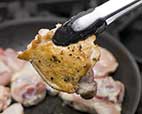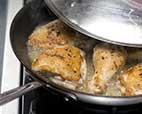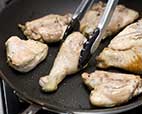Coconut Milk Yogurt (half batch)
1 can (15 oz.) organic coconut milk or lite coconut milk
heaping 1/4 t. dairy free probiotic*
Tools Needed:2 half-quart Mason jars (I used cleaned salsa jars)
large stainless steel spoon
2 large/medium stainless steel pots (I used a double boiler nested pot setup)
kitchen thermometer
a few old clean kitchen towels, a large pot and lid (large enough to hold mason jars)
OR yogurt maker
 Yeah, we have a wee bit of coconut milk hangin' around...
Yeah, we have a wee bit of coconut milk hangin' around...*I used Culturaid dairy free probiotic since it is free of many of the common allergens: gluten, dairy, yeast, corn, and soy.
*UPDATE* As several of you have pointed out, Klaire Labs has discontinued Culturaid. I've written a length response in the comments section, but to keep it short, we recommend
Dr. Ohhira's, Essential Formulas Inc., Probiotic, a 60 capsule probiotic with 12 active cultures, a 5-star rating from 300+ reviews, priced at ~$34.50 - $5 (Referal Coupon Code: JOC350), or $29.50, less than the Culturaid and other competing allergy free probiotics/yogurt starters.
Instructions for Coconut Milk Yogurt
[Gluten, Dairy, Soy, Corn, Yeast Free and Low Carb/Low Fat]
1.) Sterilize your container(s):I boiled water in my electric kettle to sterilize my yogurt jars and stainless steel pot. After the water boiled, I let it sit for 10 or so minutes while I went onto step 2. When you need two yogurt containers, just discard the hot water.
2.) Pour out the sterilizing water from the pot and pour in the coconut milk. If you didn't shake the can and the milk has separated, just give it a quick stir with a clean/sterilized stainless steel spoon. Turn the milk to medium high heat and keep your thermometer handy. Bring the milk to just boiling with your thermometer in the milk, but not resting or touching the pot (you want the temperature of the milk, not the pot).
Continuously stir the milk until it reaches around 160 degrees. I've seen the range of 170-180 degrees for "normal" milk in order to kill the bad bacteria, but the canned organic
coconut milk does not suffer bovine growth hormones, animal antibiotics passed into the cow milk, pesticides, or any chemical residues that can hamper regular milk. I am more lax with the temperature for this reason. If you'd prefer to go to the higher temperature, go for it, but
make sure to keep stirring so the milk doesn't burn. Several discussions about this post around the internet have questioned my rationale for this step - i.e. "why boil the coconut milk at all? Canned coconut milk ought to be sterilized in the canning process". This is true. The culture requires a coconut milk temperature between 80 - 100 degrees Fahrenheit, so the 160 degrees cited above is likely overkill.

3.) Set up your yogurt-making area. The yogurt culturing area can be a real yogurt maker or this handy type setup shown below. All that is necessary is that the yogurt stay around 100 degrees (or as close as possible). I placed 2 jars in my largest pot with a few warmed towels on the bottom to insulate the jars. I used 1 jar for steaming hot water and the other jar for the yogurt. Here's a
cool site for making yogurt by livelonger on HubPages which gives nice pictures and the incubation idea of a cooler and hot water instead of a yogurt maker.
4.) Let the coconut milk cool. Check the milk comes to around
100-110 degrees before adding the probiotic starter.
Once the milk has cooled, stir in the probiotic starter. If you were making normal cow-based dairy yogurt, you could use premade/purchased yogurt with live cultures instead of specialty probiotic starter. For dairy free coconut milk yogurt, we can't do this of course- hence the Culturaid.
Boil some more water and pour into one of your open jars shown above. The hot water in this jar along with the insulating towels and closed pot will help keep the yogurt jar warm so the cultures can grown during incubation.
Pour the inoculated yogurt/coconut milk into the other jar and close the lid to keep it warm. I added a few more towels for jar insulation.
5.) Cover the whole setup or your yogurt maker. I turned my pot to very very low heat (barely on) to keep the setup warm. You may not need to do this depending upon the temperature of your kitchen. It was cold and rainy when I made this (Murphy's law in action). Let the yogurt
ferment for 6-10 hours. Mine took more like 10 hours since it was so cold in my kitchen (crazy spring weather). Let the yogurt rest while it ferments.
After the allotted time has passed,
check the coconut milk yogurt. It should be firm and more of a yogurt texture. Mine was not as thick as cow milk yogurt (which often has yucky thickeners in addition to the plain old yogurt, especially if you eat the nonorganic kind), but it was definitely thicker. It had a nice slightly sweet-sour yogurt bite to it as well as all those uber healthy (nondairy) probiotics! Now I can down yogurt by the quart like Jon, right? :)
Refrigerate the yogurt when it is thick and "finished." The probiotics in yogurt and fermented foods (kraut, etc) are the "good" guys you want in your intestines to help improve your
immunity, keep you regular, build and strengthen your bones, lose weight, and detoxify you. One of my favortie online general health bloggers, Cathy Wong, has a
great summary of probiotic health benefits and possible interactions. The
Harvard Medical School Health Guide also has a good article with some interesting folk uses for yogurt.
Probiotics are especially vital in the healing process for those with compromised digestive systems, like those with IBS, Crohn's disease, and Celiac. In addition to this dairy free yourt, I love homemade red cabbage kraut and NutriWest total probiotics. I've noticed a sincere and immeasurable difference in my digestion and energy. It's just anecdotal evidence, but it does obey my "it works" philosophy. Yet another great resource is
USProbiotics.org. A general Google search on the health benefits of probiotics is overwhelming, so I'm barely scratching the surface here. Don't fret, I'll be back ranting about them much more in future posts. My other favored site for health info at World's Healthiest Foods has a
great summary on (regular) yogurt.
Keep in mind that this coconut milk yogurt is dairy free, but since it is cultured with the probiotics it will contain many of the same fermentation byproducts like some B vitamins.Oh, and
Melissa, I have not forgotten about the
6 line meme! Uhh, I am still struggling with 6 (positive.... or at least not blaringly negative) things to say about myself. Here's a try at 6 words that summarize who I am:
- independent
- open minded
- compassionate (my mom might disagree when we get into politics, hehe)
- tenacious (strong willed? what's the difference... it is subtle I guess)
- assertive
- principled (to a point of aggravation of others I'm afraid :) )
Do I get another 6 billion words to describe a bride-to-be with a few more weeks until her wedding? Suppose not .. stupid rules! Who makes up these things? Why do we need so many rules... why can't we do fun things, like list the top 6 problems with modeling the cosmic ray muon flux near the surface of the Earth? Come on, please? I could use some help and non-wedding motivation :)
Since this post is already riduclously long, I'll be back with a recipe and/or use for the yogurt later. For now I'll just stop here and go spoon some of the leftover yogurt on some freshly ground flaxseed (omega 3's, high protein, and all carbs=fiber), sliced fresh pear (keeping the washed, organic peel for fiber and vitamins), and a drizzle of blackstrap molasses (high in iron, B vitamins). Hey after writing all of this, I'll a little wiped out for a whole fancy recipe :)
A new recipe using yogurt that looks delicious is from
Natalie @ Gluten Free Mommy who whipped up some yummy
Yogurt Raspberry Lime Ice Cream. I can't wait to try it or something similar! I use the Vitamix to make many of our ice creams/sherbets, so maybe I'll toss some coconut yogurt into my old
Raspberry Smoothie in honor of your ice cream, Natalie! (I don't use the egg protein anymore, its not necessary with the coconut yogurt and protein powders are NOT health foods- they're more like weight-building short term tools (I am still trying to gain weight & muscle) and not long term health or meal replacements. The only powder is still love is Manitoba Harvest's Organic Hemp powder- it comes in protein powder, powder plus fiber, and good old hemp seeds- all with the
perfect balance of Omega3:6 fats for optimal health! It makes a
killer blueberry smoothie, Yum!












